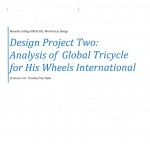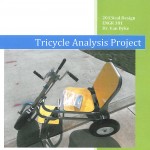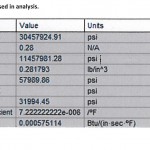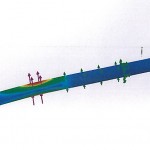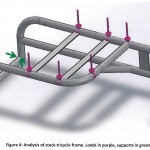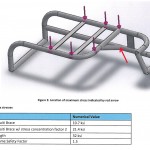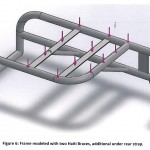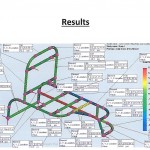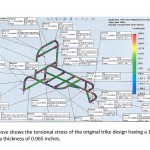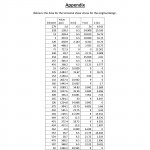Messiah College Engineering Department
Messiah College, Mechanicsburg, Pennsylvania
Messiah College continues in an ongoing relationship within our University trike Consortium. Engineering students used the trike as a class project in 2013 and again for the Spring 2014 semester. Students also took one of HWI’s trikes to Burkina Faso where they have an ongoing trike project there at an SIM Rehabilitation Center.
During 2012-13 period the staff and engineering students at Messiah College provided valuable insight into the strength properties of the basic DOTT frame design. They created and engaged in class projects in which the basic frame design was analyzed for stresses using Solidworks stress analysis tools. The results of these tests were very valuable. Along with the real world testing we have done, they have given us a lot of confidence in the basic strength of the design that has evolved
Spring 2013 ENGR 381 Mechanical Design (3) Course Description
Investigation of fundamental mechanical design concepts and methods. Application of engineering mechanics, materials, and manufacturing concepts in analysis are used to design mechanical elements and systems. Topics include combined stress, contact stress, stress concentration, fatigue, deflection, and theories of failure. Computer modeling. Design projects. Prerequisite: ENGR 333.
In the photo gallery below are some examples of the student’s computerized work
- One Report Frontt Cover
- Report Cover Page
- Properties of plain carbon steal used
- Typical trike rear axle under load stress
- Analysis of stock tricycle frame
- Haiti brace analysis
- Students analyzing possible use of 2nd brace for strength
- Frame under stress
- Torsional stress of the original trike
- Data for the torsional shear stress
His Wheels DOTT-CC trike was used as a part of the ENGR 381 Design (3) course curriculum. Students were given certain aspects of the trike for computer analysis testing. Examples of this testing will be posted at a later date.
Below is a copy of Kevin Nikolich, HWI design engineer’s response to the results of the analysis forwarded to HWI by the staff at Messiah College.
Please extend our thanks to the staff and students who contributed to computerized analysis assessment of the HWI trike design. I haven’t had a chance to really read them properly yet, just a quick scan. However, it is already clear that the research they have done has answered a few important questions concerning frame stresses in some specific areas of the trike. As a result, we can probably advise future builders much better on how to strengthen the trike if they have an unusually heavy user (second Haiti Brace) as well as other issues.
I too have long wondered if our other weakest point was in the front fork joint with the “steering tube”. But, as the students also noted in their reports, in real life it seems to hold up well under abuse. At least we know to keep an eye on that area. I suspect that sticking with the larger 1-1/4″ tubing diameter might give us a little extra strength at that joint due to the longer and larger perimeter in the weld joint
with the bigger tube. This may be one argument for staying with the larger tube size, at least on the front end. Again, it was great to see the data that came out of their research in this area.
It was also interesting to see that there was not much strength loss by switching to the 1″ diameter tube for the main frame. That is good to know.
Some of the other issues the students seem to have wondered about from a mechanical perspective actually have their roots in ergonomic necessities. The mounting of the tiller up close to the pedals ended up being the better solution in the end, although making initial assembly and adjustment more complex. We only found this out after having done it several different ways. Of course, this requires resetting the crank height (down lower in their example) to the correct ergonomic height…and then shortening the chain again to match. This is a pain, but it gives the best ergonomics in our opinion. Also, moving the brake to an entirely different location seems to create other problems for us. Sometimes there just is no ideal solution…just the least bad one.
Gear (drive) ratio is an interesting subject. The optimal drive ratio depends on the terrain and the user…and it varies wildly. These days, we just ship our trikes with a ratio that is easy to use on rough terrain at easy walking speeds. Usually, that means that it will feel too slow on smooth pavement to young people in good physical condition (college students). If only we could find a cheap and indestructible way to add multiple speeds…..that required no maintenance!
Incidentally, the use of parallel hand cranks is a good solution to the initial feeling of directional instability the students refer to. However, this crank arrangement can lack low speed torque when trying to get started in rough terrain, particularly if you are in a “dead spot” in the pedal rotation. The good news is that, strangely, for most people that feeling of “directional instability” largely goes away as their thinking process adapts to the trike, oftentimes within a mile or less. We have heard this complaint often from first time users (ourselves included…at first) but then it just seems to go away….
Excellent suggestion on the “twisting brake shoe” issue, by the way. We may use that. This was a classic example of me designing something as “lightly” as I could to see what I could get away with. It was also a classic example of a failure. As soon as this problem began to manifest itself (right after we shipped the trike to you) we started to weld a 5″ length of “L” section steel over the top of the brake shoe to create a sort of triangular “tube” section that resisted the twisting motion of the shoe. However, the suggestion of your students is a good solution too. We may try that and see if it has more advantages to it in the end.
Again, please thank your students and staff for the effort put into this project. I am sure it will benefit many for years to come.
Kevin Nikolich Design Engineer His Wheels International





